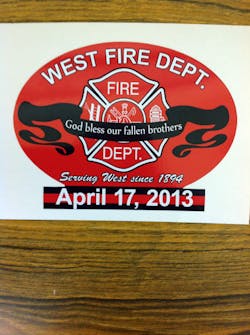State: West Firefighters Not Prepared for Fertilizer Plant Fire
May 16--Minutes before the West Fertilizer Plant exploded last year, killing 15 people, firefighters responding to a blaze there were preparing hoses while a former colleague and plant employee urged everyone to retreat.
Some minimized the danger, not thinking the night would end in one of the deadliest industrial disasters in recent memory.
"It could never get hot enough for it to go off," Cody Dragoo told a fellow firefighter, according to a report released late Thursday.
More than a year later, the Texas Fire Marshal is suggesting local agencies have fire protection plans in place and store ammonium nitrate differently in the hopes the type of explosion that rocked West never happens again.
The report, a minute-by-minute accounting of the massive explosion that killed 12 people who responded to the fire and three others, is the most detailed account of the deadly blast. In it, state investigators made 11 recommendations ranging from better on-scene leadership to improved training so volunteer departments know when to fight and when to fall back while dealing with hazardous chemicals.
Officials, however, said the first responders acted in the manner consistent with their training, which was limited. As a result of that lack of adherence to some nationally-accepted firefighting policies, "the fire department exposed firefighters to excessive risks and failed to remove them from a critically dangerous situation."
"The strategy and tactics utilized by the West Volunteer Fire Department were not appropriate for the rapidly developing and extremely volatile situation."
State fire marshals also confirmed three of the dozen men who responded to the blast had alcohol or drugs in their system, according to autopsies.
Firefighters raced to the fire at 7:29 p.m. on April 17, many fully aware the fertilizer plant was a stockpile of ammonium nitrate. The volunteer department quickly started lying down lines.
Dragoo, who also worked at the plant, told firefighters at the scene he believed the majority of the fertilizer was away from the center of the fire, and he doubted the blaze would cause the 20-to-30 tons of ammonium nitrate to ignite.
A former firefighter and former fertilizer plant worker, Brian Renegar, saw things differently, according to the report. He called firefighter Kevin Maler as Maler headed from the plant to the fire station for gear for the volunteers who responded to the scene.
Renegar told Maler "they needed to evacuate the plant to at least a quarter-mile distance" because of the explosion risk.
Six minutes after Dragoo predicted the plant would not explode and Renegar warned to pull back, officials began evacuating a nearby nursing home. Four minutes later the fertilizer plant exploded with a force that registered a 2.1 earthquake at a nearby monitoring station. The explosion, which occurred 12 minutes after the fire was reported, left a crater 90 feet wide and 10 feet deep, according to the report.
The ensuing blast killed the first responders and two nearby residents. A third resident died the following day. Officials said more than 200 injuries and $100 million in damage was caused by the explosion in a 37-block area.
To avoid similar tragedies, officials said volunteer departments need additional training and precise procedures for setting up incident commands and quickly assessing the dangers of chemicals stored in their area.
"The emergency scene operation was conducted in an unstructured and uncoordinated manner, without overall direction and without adequate supervision," state fire officials said.
Further, officials noted better storage and care of hazardous materials -- including sprinkler systems in buildings where chemicals like ammonium nitrate are stored -- might have controlled or contained the fire.
The report also called for local areas to have a fire prevention code so rules and regulations are clearly identified and followed. Currently, Texas counties with a population greater than 250,000 or adjacent to a county with a population greater then 250,000 can establish fire codes.
That code should also include planning for hazardous material events, and retroactively apply to existing structures, such as Texas' 51 towns where permits allow more than 10,000 pounds of ammonium nitrate to be stored.
Thursday's report is the second round of information the town has received about the disaster in the past month. Members of the U.S. Chemical Safety Board visited West in April and said shortcomings at every level of government contributed to the blast.
In their assessment, chemical board members blamed lax enforcement and improper storage for making the disaster exponentially worse. Rafael Moure-Eraso, the Chemical Safety Board's chairman, called for new rules limiting the amount of ammonium nitrate stored at one site, and require storage in fireproof conditions.
Residents, many of whom were driven from their destroyed homes by the blast, have been divided on some issues focusing attention on West. The community has some residents who want to return bulk fertilizer sales to the area. Others are wary of putting a plant inside the town again.
State lawmakers started work months ago on recommendations listed in the report, including better training and requirements for local fire protection plans.
Rep. Joe Pickett, D-El Paso, chairman of the House Homeland Security and Public Safety Committee, said Thursday he planned to have legislation drafted by late June or July, so the committee could have a firm idea of a final plan by the start of the session.
Copyright 2014 - Houston Chronicle
